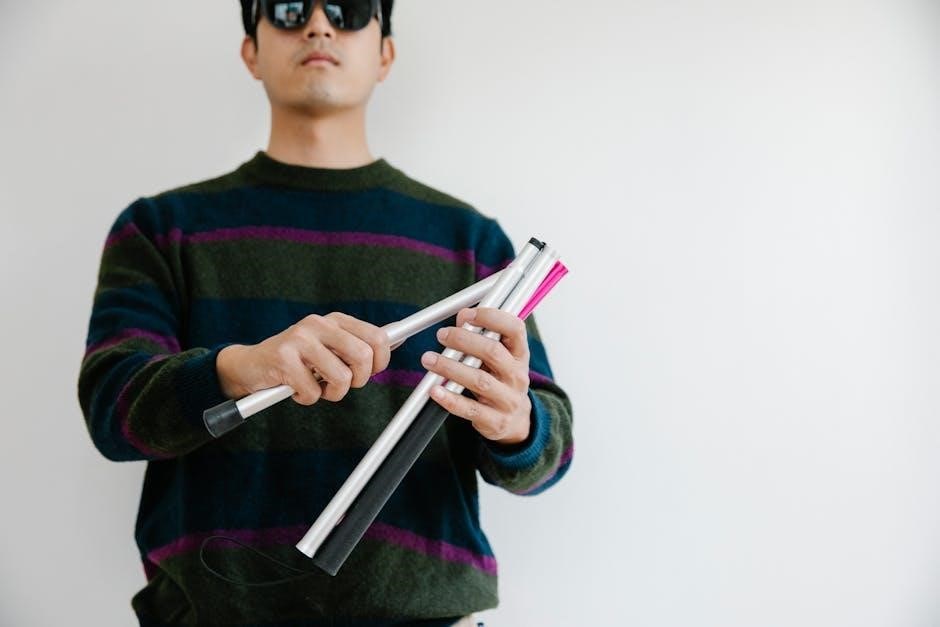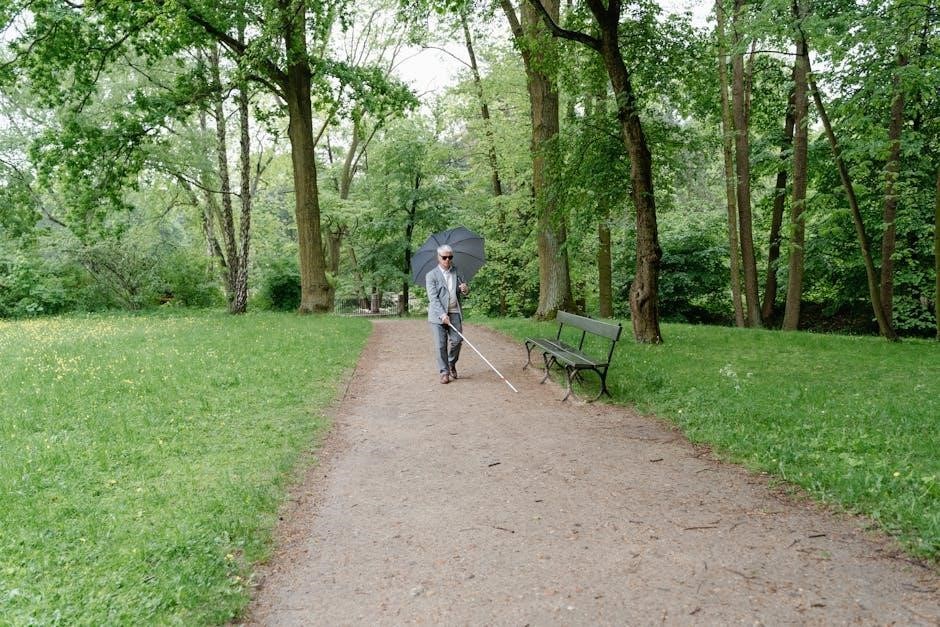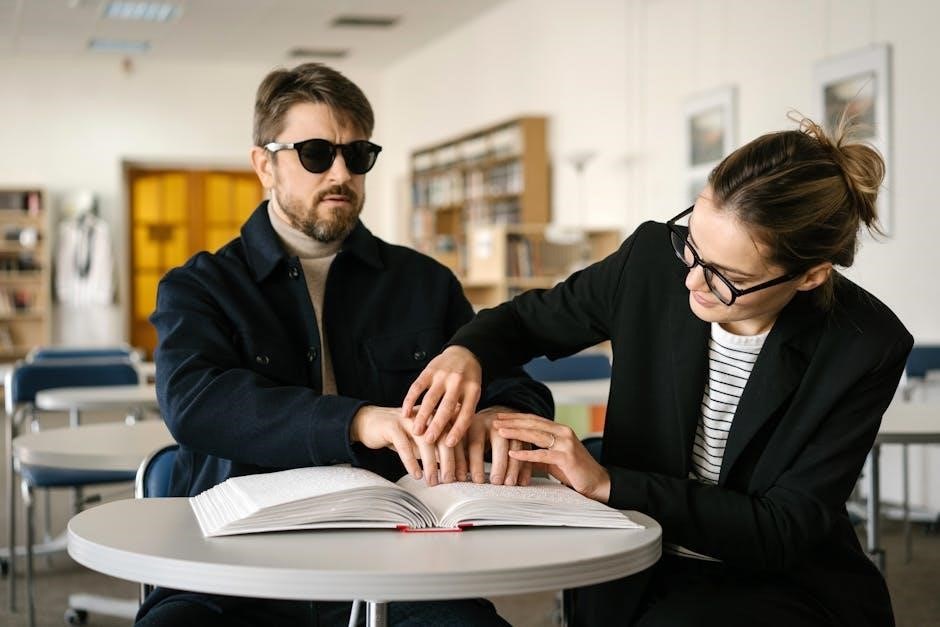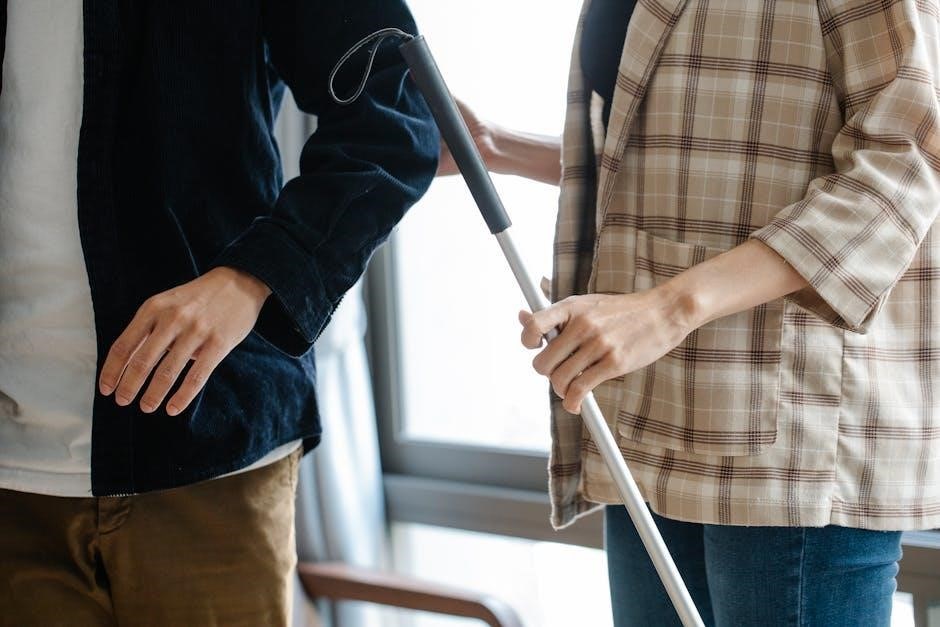Visually impaired running guides empower individuals with visual impairments to enjoy the freedom of running independently. Guides provide verbal cues and physical tethering, ensuring safety and confidence during workouts.
Overview of the Importance of Running Guides
Running guides play a vital role in empowering visually impaired individuals to run independently and confidently. They provide essential verbal cues and physical tethering, enabling safe navigation and real-time communication. This partnership fosters independence, builds trust, and enhances overall well-being. Guides not only assist in overcoming physical challenges but also contribute to mental resilience and social inclusion, making running accessible and enjoyable for all.
Benefits of Running for Visually Impaired Individuals
Running offers numerous benefits for visually impaired individuals, enhancing physical fitness, mental well-being, and independence. It improves cardiovascular health, strengthens muscles, and boosts flexibility. Additionally, running fosters confidence, reduces stress, and promotes a sense of achievement. It also encourages social interaction, as runners often connect with guides and communities. Overall, running empowers visually impaired individuals to embrace an active lifestyle, fostering resilience and self-esteem while breaking barriers to participation in physical activities.

Understanding the Role of a Sighted Running Guide
A sighted running guide provides verbal cues and physical tethering, ensuring the visually impaired runner’s safety and independence while fostering confidence and teamwork during workouts.
Responsibilities of a Sighted Guide
A sighted running guide is responsible for providing clear verbal cues about the environment, such as obstacles, turns, and terrain changes. They must also offer physical guidance through tethering, ensuring the runner’s safety and stability. Guides should communicate effectively, describing landmarks and potential hazards while maintaining a steady pace. Additionally, they must be attentive to the runner’s needs, offering encouragement and adjustments as necessary. Their role is crucial in fostering independence and confidence for visually impaired runners during training and races.

Communication Techniques for Effective Guidance
Effective communication is vital for sighted guides to ensure smooth navigation. Guides should use clear, concise verbal cues to describe obstacles, turns, and terrain changes. They may also use tactile cues, such as gentle tugs on a tether, to signal direction shifts. Consistency in commands and tone helps the runner anticipate movements. Guides should actively listen to the runner’s feedback, adjusting their communication style as needed. This collaborative approach fosters trust and ensures a safe, enjoyable running experience for both parties.

Training and Preparation for Visually Impaired Runners
Training involves structured programs tailored to individual needs, focusing on adaptive techniques and building confidence. Guides support runners through consistent verbal cues, fostering independence and skill development.
Building Confidence and Independence
Building confidence and independence is crucial for visually impaired runners. Guides play a vital role by providing consistent verbal cues and physical support, helping runners feel safe and self-assured. Over time, runners develop trust in their guides and themselves, fostering independence. Adaptive techniques, such as step counting and spatial awareness, empower runners to navigate environments confidently. Positive reinforcement and gradual progression from guided to semi-independent running further enhance self-esteem, enabling runners to embrace their capabilities fully.
Physical and Mental Preparation Strategies

Physical preparation for visually impaired runners involves strengthening muscles, improving balance, and enhancing endurance through tailored exercises. Guides assist in navigating terrain safely, providing real-time feedback. Mentally, runners benefit from mindfulness practices, positive affirmations, and goal setting to build resilience. Adaptive techniques, such as using screen readers or tactile markers, further support independence. Regular practice fosters confidence, while guides offer encouragement, helping runners overcome challenges and achieve their full potential in a supportive and inclusive environment.

Safety Measures for Visually Impaired Running
Safety measures include guides providing verbal cues and using tethers. Runners should stay alert to surroundings, wear reflective gear, and carry ID tags with emergency contacts.
Essential Safety Tips for Runners and Guides
Safety is paramount for visually impaired runners and their guides. Clear verbal communication is crucial, with guides describing obstacles and changes in terrain. Tethering ensures physical connection, aiding stability. Runners should wear reflective clothing for visibility and carry identification with emergency contacts. Guides must stay alert to surroundings and plan routes in advance to avoid hazards. Both should be aware of traffic and weather conditions, ensuring a safe and enjoyable running experience.

Handling Emergencies During Runs
In emergencies, guides must remain calm and prioritize the runner’s safety. If a fall occurs, the guide should assess injuries and provide clear, reassuring instructions. Carrying a phone or emergency contact information is essential for summoning help. Guides should be trained in first aid and know how to navigate safely to a secure location. Communication devices can help alert others if needed. Ensuring the runner’s well-being and stability is crucial before continuing the run or seeking further assistance.

How to Find or Become a Running Guide
To find or become a running guide, connect with local guide services or organizations. Volunteers can train to assist visually impaired runners, fostering independence and joy in running.
Locating Local Guide Services
Locating local guide services involves researching organizations that specialize in supporting visually impaired runners. Start by searching online for groups like para-guides or local running clubs that offer guide services. Many communities have dedicated programs, such as the “Find a Guide” initiative, which connects visually impaired individuals with trained volunteers. Additionally, reaching out to local disability organizations or sports clubs can provide valuable resources. Websites and social media platforms often list nearby guide services, making it easier to find support tailored to your needs. Connecting with these groups ensures accessibility and fosters a sense of community for visually impaired runners.
Volunteering as a Guide Runner
Volunteering as a guide runner is a rewarding way to support visually impaired individuals in their running journeys. Many organizations, such as local running clubs or disability groups, offer opportunities to become a guide. Training is often provided to ensure guides can effectively communicate and assist. As a guide, you’ll provide verbal cues, physical guidance, and encouragement, helping runners navigate safely and confidently. This role not only fosters independence for visually impaired runners but also builds meaningful connections and a sense of community for everyone involved.

Technology and Assistive Devices for Visually Impaired Runners
Assistive devices like GPS-enabled apps, screen readers, and wearable sensors enhance independence for visually impaired runners, providing real-time feedback and obstacle detection during their workouts.
Popular Assistive Devices for Running
Visually impaired runners utilize various assistive devices to enhance their running experience. GPS-enabled apps provide real-time location feedback, while screen readers convert text to speech for navigation. Wearable sensors detect obstacles and track performance metrics. Tactile devices, like vibration-enabled wristbands, signal changes in terrain. Additionally, specialized apps, such as “Find a Guide,” connect runners with sighted guides. These tools promote independence, safety, and confidence, enabling visually impaired individuals to run more effectively and enjoy the sport with greater ease and accessibility.
Apps and Tools for Blind Runners
Blind runners benefit from innovative apps and tools designed to enhance their running experience. GPS navigation apps provide real-time audio feedback on distance, pace, and route. Accessibility-focused apps, such as “Find a Guide,” connect runners with sighted guides for safe companionship. Screen readers and voice-over features on smartphones enable runners to access critical information. Additionally, apps like “WalkyTalky” offer verbal descriptions of surroundings, promoting independence. These tools empower visually impaired runners to navigate confidently and enjoy the sport with greater ease and accessibility.

Real-Life Stories and Experiences
Inspiring stories highlight visually impaired runners’ resilience and determination. Runners like Libby Clegg, a blind athlete, have shattered barriers, showcasing the power of adaptability and teamwork. Guides play a pivotal role in these journeys, enabling runners to achieve remarkable feats. These real-life experiences underscore the transformative impact of running on confidence and independence, offering hope and motivation for others to embrace the sport.
Success Stories of Visually Impaired Runners
Visually impaired runners, like Libby Clegg and Tanner Gers, exemplify determination and resilience. Clegg, a blind athlete, won a T11 100m heat with a world-record time, showcasing exceptional skill. Guides play a pivotal role, providing verbal cues and physical tethering to ensure safety. These success stories highlight the transformative power of running, fostering confidence and independence. They inspire others to embrace the sport, proving that visual impairment is not a barrier to achieving greatness with the right support and teamwork.
Challenges Faced by Runners and Guides
Visually impaired runners and their guides encounter unique challenges, such as synchronization of movement and communication. Safety concerns, like navigating obstacles, require precise verbal cues. Building trust and timing is crucial, as missteps can lead to accidents. Additionally, runners may face disqualification if guides are deemed too involved, as seen in Libby Clegg’s case. These challenges highlight the importance of effective teamwork, clear communication, and adaptive strategies to ensure a safe and successful running experience for both parties.
Visually impaired running guides foster independence and confidence, enabling runners to thrive. With proper training, communication, and community support, the future of inclusive running looks promising and inspiring.
Encouraging Participation in Running
Encouraging visually impaired individuals to participate in running involves fostering a supportive environment and highlighting the benefits of physical activity. Guides play a crucial role in building trust and confidence. Awareness campaigns can help reduce stigma and promote inclusivity. Providing access to trained guides, assistive devices, and adaptive programs ensures equal opportunities. Encouraging runners to share their experiences also inspires others to take up the sport. Community support and mentorship are key to helping visually impaired individuals embrace running as a fulfilling and empowering activity.
Future of Visually Impaired Running Guides
The future of visually impaired running guides lies in advancing technology and expanding community support. Innovations like AI-powered navigation tools and wearable devices will enhance independence for runners. Increased awareness and accessibility initiatives will encourage more visually impaired individuals to participate. Additionally, standardized training programs for guides will improve safety and effectiveness. As inclusivity grows, visually impaired running guides will become more integrated into mainstream running communities, fostering a culture of equality and empowerment for all athletes.